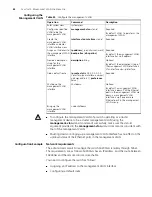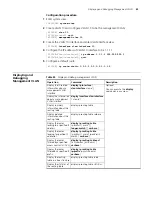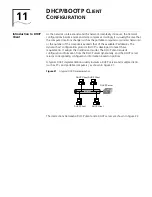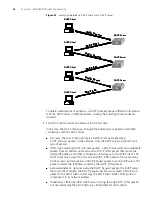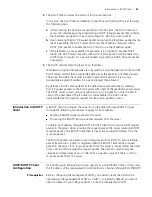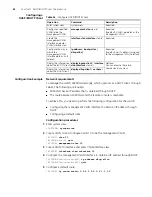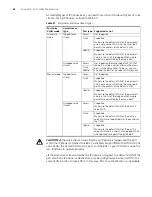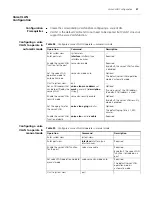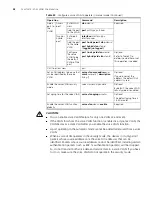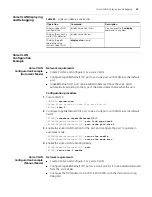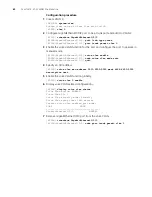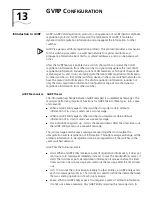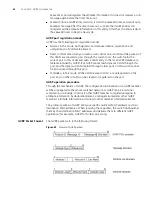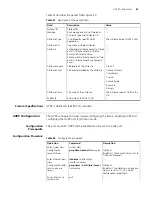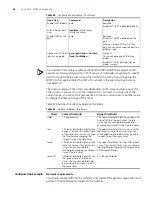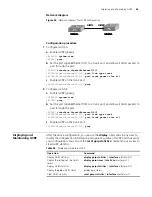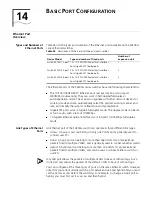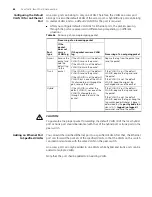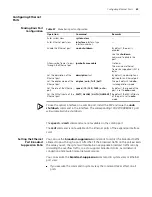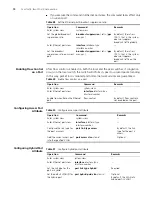
62
C
HAPTER
13: GVRP C
ONFIGURATION
Leave timer, and unregisters the attribute information if it does not receives a Join
message again before the timer times out.
■
LeaveAll: Once a GARP entity starts up, it starts the LeaveAll timer, and sends out a
LeaveALL message after the timer times out, so that other GARP entities can
re-register all the attribute information on this entity. After that, the entity restarts
the LeaveAll timer to begin a new cycle.
GVRP port registration mode
GVRP has the following port registration modes:
■
Normal: In this mode, both dynamic and manual creation, registration and
unregistration of VLANs are allowed.
■
Fixed: In this mode, when you create a static VLAN on a switch and the packets of
this VLAN are allowed to pass through the current port, the switch joins the
current port to this VLAN and adds a VLAN entry to the local GVRP database (a
table maintained by GVRP). But GVRP cannot learn dynamic VLAN through this
port, and the dynamic VLANs learned through other ports on this switch cannot
be pronounced through this port.
■
Forbidden: In this mode, all the VLANs except VLAN 1 are unregistered on the
port, and no other VLANs can be created or registered on the port.
GARP operation procedure
Through the mechanism of GARP, the configuration information on a GARP member
will be propagated to the whole switched network. A GARP can be a terminal
workstation or a bridge; it instructs other GARP member to register/unregister its
attribute information by declaration/recant, and register/unregister other GARP
member's attribute information according to other member's declaration/recant.
The protocol packets of GARP entity use specific multicast MAC addresses as their
destination MAC addresses. When receiving these packets, the switch distinguishes
them by their destination MAC addresses and delivers them to different GARP
application (for example, GVRP) for further processing.
GVRP Packet Format
The GVRP packets are in the following format:
Figure 23
Format of GVRP packets
Summary of Contents for 4200G 12-Port
Page 10: ...8 CONTENTS...
Page 14: ...4 ABOUT THIS GUIDE...
Page 46: ...32 CHAPTER 5 LOGGING IN THROUGH WEB BASED NETWORK MANAGEMENT SYSTEM...
Page 48: ...34 CHAPTER 6 LOGGING IN THROUGH NMS...
Page 60: ...46 CHAPTER 9 VLAN CONFIGURATION...
Page 64: ...50 CHAPTER 10 MANAGEMENT VLAN CONFIGURATION...
Page 80: ...66 CHAPTER 13 GVRP CONFIGURATION...
Page 98: ...84 CHAPTER 15 LINK AGGREGATION CONFIGURATION...
Page 112: ...98 CHAPTER 18 MAC ADDRESS TABLE MANAGEMENT...
Page 126: ...112 CHAPTER 19 LOGGING IN THROUGH TELNET...
Page 162: ...148 CHAPTER 20 MSTP CONFIGURATION...
Page 274: ...260 CHAPTER 29 IGMP SNOOPING CONFIGURATION...
Page 276: ...262 CHAPTER 30 ROUTING PORT JOIN TO MULTICAST GROUP CONFIGURATION...
Page 298: ...284 CHAPTER 33 SNMP CONFIGURATION...
Page 304: ...290 CHAPTER 34 RMON CONFIGURATION...
Page 338: ...324 CHAPTER 36 SSH TERMINAL SERVICES...
Page 356: ...342 CHAPTER 38 FTP AND TFTP CONFIGURATION...
Page 365: ...Information Center Configuration Example 351 S4200G terminal logging...
Page 366: ...352 CHAPTER 39 INFORMATION CENTER...
Page 378: ...364 CHAPTER 40 BOOTROM AND HOST SOFTWARE LOADING...
Page 384: ...370 CHAPTER 41 Basic System Configuration and Debugging...
Page 388: ...374 CHAPTER 43 NETWORK CONNECTIVITY TEST...
Page 406: ...392 CHAPTER 45 CONFIGURATION OF NEWLY ADDED CLUSTER FUNCTIONS...

